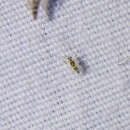en
names in breadcrumbs


Cricotopus sylvestris formerly Cricotopus silvestris, is a species of midge in the family Chironomidae. It is found in Asia, Europe, The United Kingdom, and North America.[1][2][3][4]
It is believed that the complete development of this species from larvae to adult is temperature dependent. In laboratory conditions, larvae completed development in 10 days at 22° and 29 °C. When temperatures were at 15°, it took 28 days. The production to biomass (P/B) ratio for this species has one of the highest values reported for chironomids.[5] Midge larvae are often eaten by other invertebrates, such as damselfly naiads/Nymph (biology), and fish. In North America, it is noted that this species is a natural enemy of Berosus ingeminatus and Ischnura verticalis[4]
In the U.K, this species is considered to be native but with a sporadic range.[6]
Cricotopus sylvestris formerly Cricotopus silvestris, is a species of midge in the family Chironomidae. It is found in Asia, Europe, The United Kingdom, and North America.